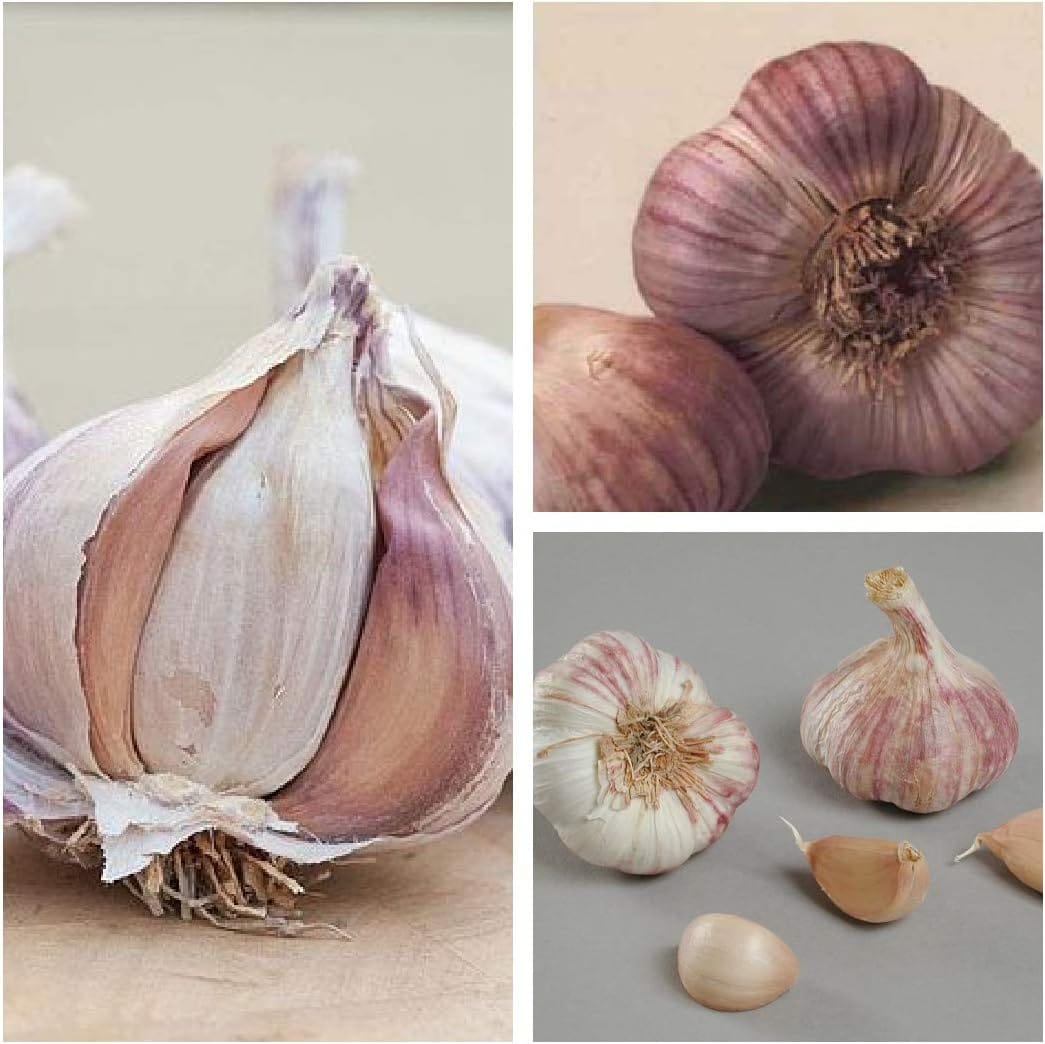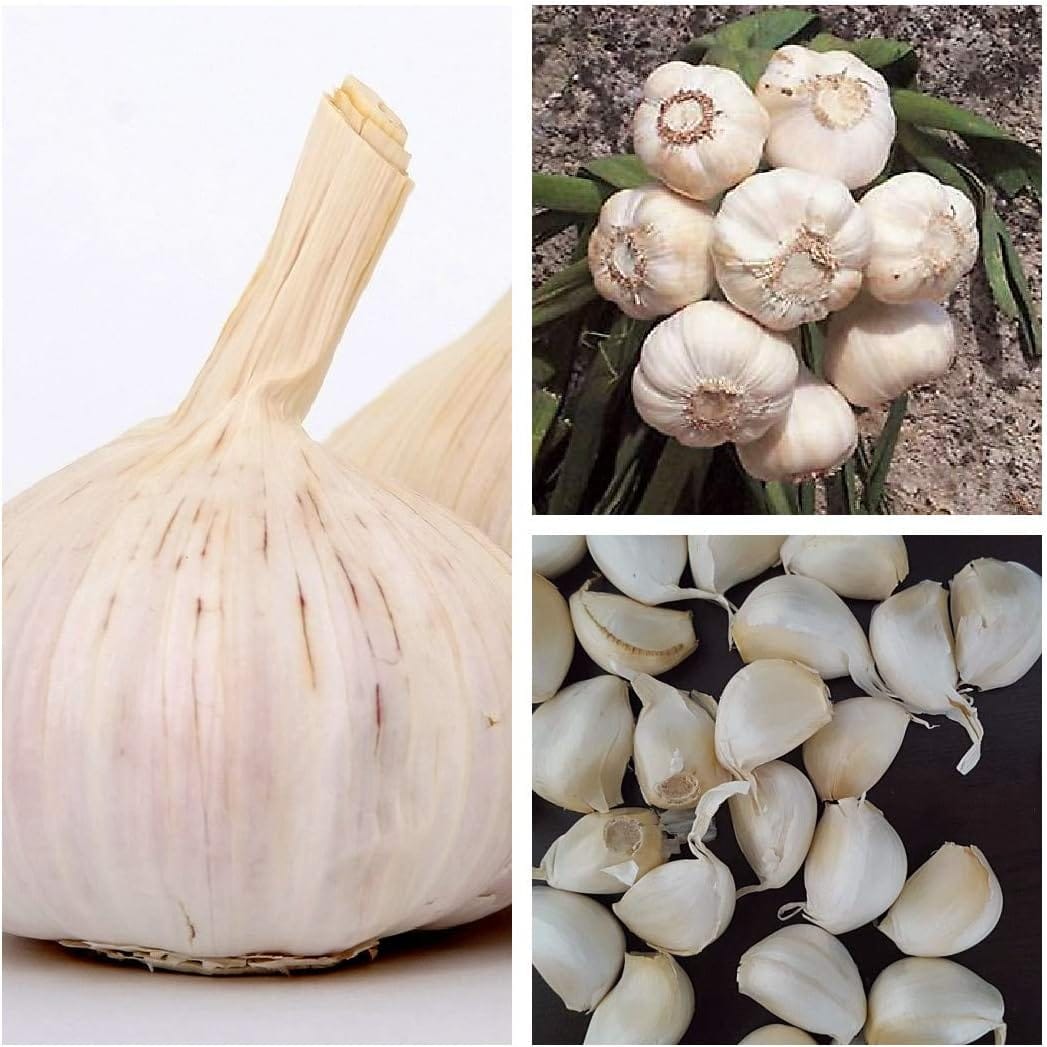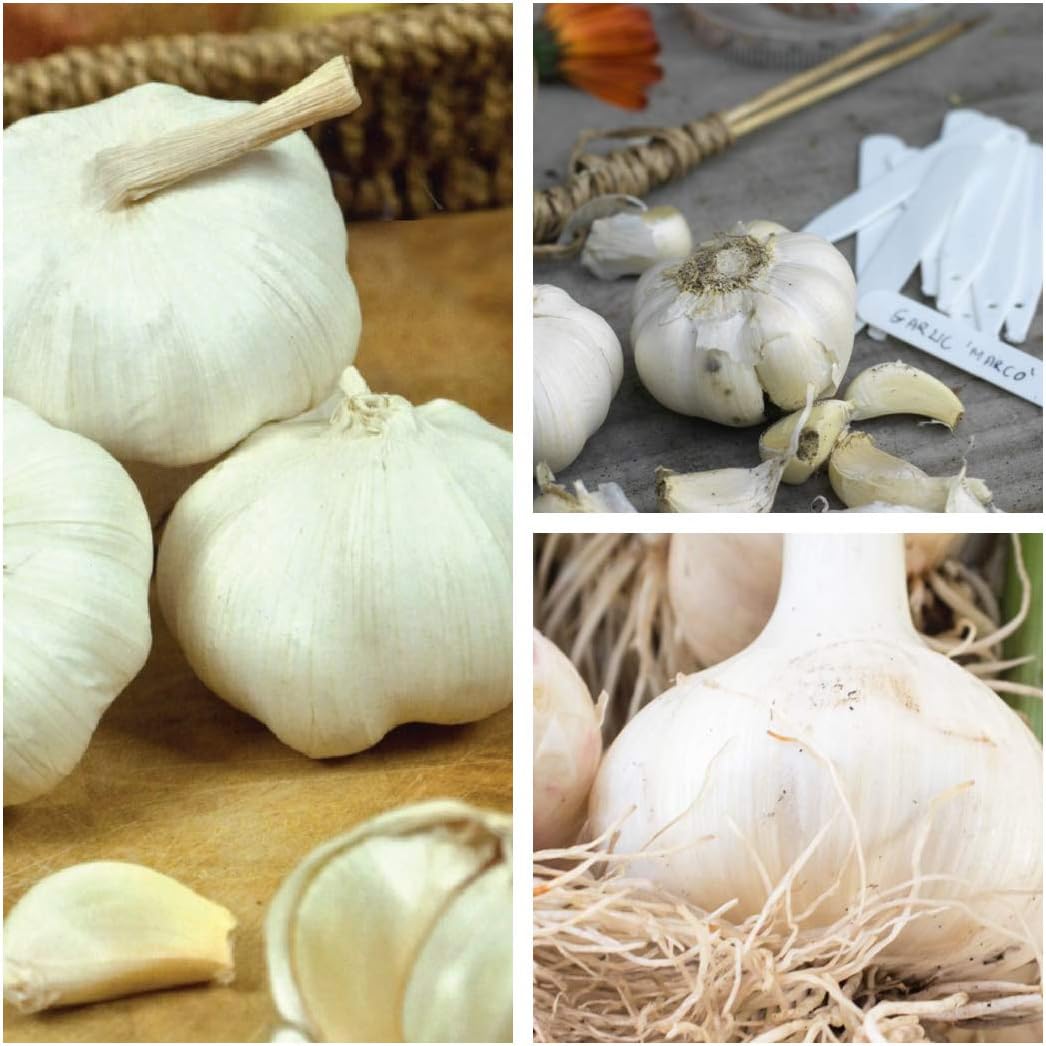Growing garlic in your garden can be a rewarding and beneficial endeavour for both novice and seasoned gardeners. This resilient crop not only adds robust flavour and aroma to a multitude of dishes, but it also boasts numerous health benefits, including antibacterial and anti-inflammatory properties. Garlic is relatively easy to cultivate, requiring minimal maintenance once planted. Furthermore, it offers the advantage of long-term storage, allowing you to enjoy the fruits of your labour throughout the year. Whether you’re aiming to enhance your culinary creations or embark on a new gardening adventure, garlic makes an excellent choice for your garden. (see also our planting guide at the bottom of the blog).
Why We Chose These 3 Varieties
After conducting extensive research and thoroughly evaluating various reviews, I identified these three varieties of garlic bulbs as the best options available based on my personal experience and the insights gathered. Among them, I have chosen Carabeth Plants as my preferred supplier. My decision stems from my limited experience with other suppliers, which makes me more confident in opting for a name that has garnered positive feedback and a reputation for quality in the market. The unique features and offerings of Carabeth Plants align well with what I was seeking, making it a fitting choice for my needs.
Hardiness and Resilience: As experienced gardeners, we selected these varieties for their ability to thrive in a range of climates and soil conditions. Their hardy nature ensures a successful harvest even in less-than-ideal growing environments.
- Flavour: The chosen varieties are renowned for their distinctive and robust flavour. They provide a rich culinary experience, enhancing the taste of dishes with their unique aromatic qualities, making them a favourite among chefs and home cooks alike.
- Disease Resistance: These garlic varieties have demonstrated strong resistance to common pests and diseases, reducing the need for chemical interventions and ensuring a healthy crop. This makes them an ideal choice for organic gardeners.
- Yield and Storage: With above-average yield potential and long-term storage capabilities, these varieties promise a plentiful harvest that can sustain culinary needs throughout the year, reducing the frequency of planting cycles.
- Adaptability and Versatility: The flexibility of these varieties allows them to be used in diverse culinary applications, from raw consumption to various cooking methods. Their adaptability also extends to different gardening setups, whether in-ground or container gardening.

Garlic "Germidor Pink"
Well-rounded, mild flavour that enhances a variety of culinary dishes
- Type: As a softneck variety, it is easier to braid and store. Originating from France, this variety is well adapted to British conditions, making it a reliable choice for UK gardeners.
- Flavour: Germidour garlic is celebrated for its well-rounded, mild flavour that enhances a variety of culinary dishes.
- High Yielding: Known for its prolific growth, Germidour garlic produces large white bulbs with purple hues, making it both aesthetically pleasing and abundant. Each bulb typically contains 10-12 cloves, offering generous amounts for planting or culinary use.
- Harvest Timeline: This fast-growing variety can be harvested from May. The garlic bulbs are semi-dry by June and fully dry by July, ensuring a steady supply.
- Special Features: Germidour is cultivated to be virus-free, ensuring healthy growth and robust bulbs.

Garlic Bulbs 'Cristo'
strong flavour with a light aroma, making it an excellent choice for enhancing various dishes with its distinct taste.
- Type: Softneck. This is a continental variety that thrives in different climates. It produces plump, white-skinned cloves that are both visually appealing and highly practical for culinary use.
- Flavour: Cristo garlic bulbs are known for their delicious, strong flavour with a light aroma, making them an excellent choice for enhancing various dishes with its distinct taste.
- Yielding: It produces abundant crops, with each bulb yielding a generous number of cloves, ensuring a prolific harvest for culinary enthusiasts and gardeners alike.
- Harvest Timeline: Garlic 'Cristo' can be planted in autumn, early winter or spring, depending on preference, allowing flexibility for gardeners. It yields bumper crops ready for harvesting in the summer, offering a reliable and steady supply.
- Special Features: Besides its culinary uses, this variety is also renowned as a companion plant due to its strong insect-repellent properties. Planting garlic 'Cristo' near other plants can help protect them from pests, making it a valuable addition to any garden.
- Type: Softneck. Garlic Marco is characterised by its soft neck structure, producing bulbs with small, tightly packed cloves. The variety is noted for its ability to store well for several months, maintaining its potency and freshness over time.
- Flavour: This garlic is celebrated for its strong, distinctive flavour and fine, white skin. Those seeking to infuse their cooking with a robust zing will find Garlic Marco an ideal choice, elevating dishes with its intense taste.
- Yielding: Despite their compact size, the bulbs yield an impressive number of cloves, ensuring a generous harvest suitable for both culinary enthusiasts and home gardeners looking to enjoy the garlic's vibrant flavour.
- Harvest Timeline: Garlic Marco offers flexibility in planting, allowing for planting in either autumn or spring. The bulbs reach maturity by summer, ensuring a continual supply of fresh garlic for several months.
- Special Features: As a soft neck variety, Garlic Marco is advantageous for gardeners interested in a low-maintenance plant that seldom flowers, making it a practical and reliable choice for consistent yields.
Judges Verdict
In conclusion, planting garlic is a rewarding endeavour for any gardener, offering both culinary delights and natural pest-control benefits. When selecting garlic varieties, considering options available on platforms like Amazon can provide access to a diverse range of types such as Garlic 'Cristo' and Garlic Marco. These varieties are well-suited for different planting preferences and conditions, providing good yields and strong flavours that can enhance any dish. As the planting season arrives, exploring these options can help you choose the best garlic varieties that align with your gardening needs and culinary desires, ensuring a fruitful and flavorful harvest.
Alternatively, check out these varieties on the following sites as an alternative for more options or try your local garden centres.Early purple wight, Elephant garlic, Solent Wight
The Garlic Farm Isle of Wight specialist supplier and breeder of garlic varieties.
Check out Suttons for garlic bulbs as another excellent resource for finding a variety of garlic options to suit your gardening needs.
Q&A
When is the best time to Plant Garlic Bulbs?
The timing of garlic planting is crucial for a successful harvest. For the best results, garlic cloves should typically be planted in the autumn. This allows the cloves to establish strong root systems before winter sets in, giving them a head start when spring arrives. Planting in October or November (autumn to early winter) is ideal, but regions with milder winters can extend this period into December. Alternatively, garlic can also be planted in early spring, though the yields may not be as robust as autumn-planted garlic. Observing local climate conditions and frost dates can aid in determining the perfect planting window, ensuring healthy growth and an abundant harvest.
Can I plant my garlic bulbs outside?
Absolutely, you can plant garlic outside in the UK! Just make sure to choose a well-drained spot and plant your cloves in autumn or early spring for the best results.
Why is my garlic not forming bulbs?
Garlic's failure to form bulbs can be due to several factors, including poor soil quality and incorrect planting depth. Ensure you're planting cloves in well-drained, fertile soil and at a depth of around 2.5 cm. Proper care in the UK climate also involves providing adequate water and avoiding overcrowding.
How do I prevent garlic from getting rust fungus?
Rust fungus is a common issue in damp climates. To prevent garlic rust, practice crop rotation, ensure good air circulation, and avoid overhead watering. Using a natural fungicide can also help protect your garlic plants in the UK climate.
My garlic stems are yellowing. What could be the cause?
Yellowing stems often indicate nutrient deficiencies or overwatering. Conduct a soil test to check for nutrient imbalances and adjust fertilisation accordingly. Ensure your garlic is planted in well-drained soil to prevent waterlogging.
What is the best soil to use for planting in containers?
Plant garlic in well-drained soil and provide adequate spacing to improve air circulation. Mulching can also help manage moisture levels. Garlic rot is typically caused by excessive moisture or fungal infections and poorly draining soil. Add a little sand to a good potting compost with added organic content compost to improve drainage and success.
How can I protect my garlic from pests like onion fly
To deter pests such as onion fly, consider using physical barriers like netting. Crop rotation and interplanting with pest-repelling plants like marigolds can also be effective in managing pest issues.
Why are my garlic cloves splitting?
Clove splitting can result from fluctuating moisture levels or delayed harvesting. Maintain consistent watering practices and monitor your garlic’s maturity to harvest at the right time.
How do I ensure my garlic is ready for harvest?
Garlic is typically ready for harvest when the lower leaves begin to yellow. In the UK, this usually occurs around mid to late summer. Use a fork to gently lift the bulbs from the soil, ensuring they are mature for curing.
What should I do if my garlic is producing flower stalks?
When garlic produces scapes or flower stalks, it diverts energy from bulb formation. Removing these scapes as they appear will help the plant focus on bulb production, enhancing your harvest.
Can poor soil affect garlic growth?
Yes, poor soil can greatly affect growth. Garlic thrives in rich, loamy soil with a pH of 6.0-7.5. Amending your soil with organic matter and ensuring good drainage will support healthy growth.
How can I store garlic after harvest?
Proper storage is key to preserving garlic. After curing in a warm, dry place for 2-3 weeks, store garlic in a cool, dark, and well-ventilated area. Avoid storing in the refrigerator, as this can initiate sprouting.
Planting Guide for Growing Garlic Bulbs
- Soil Preparation: Garlic prefers well-drained soil with a pH of 6.0 to 7.0. Improve clay or sandy soils by adding organic matter like compost or well-rotted manure. For containers use a general multipurpose compost with organic matter and add a little sand for drainage. If using peat-free such as Melcourt Sylvagrow Peat-Free, add some organic matter to it.
- Planting Time: Plant in autumn (October to November) or early spring (February to March). Autumn planting allows for a longer growing period and larger bulbs.
- Clove Selection: Use healthy bulbs and break them gently down into cloves. Only use firm cloves and disregard any damaged ones.. Avoid using supermarket garlic as it may not be suitable for UK conditions.
- Proper Spacing: Plant cloves 15cm apart in rows 30cm apart. Ensure the pointed end of the clove is facing upwards and the clove is 2.5cm deep.
- Pots/Containers: use a minimum of 15cm pot. i would put 2 in just in case one fails.
- Watering Needs: Garlic requires consistent moisture, especially during dry spells in spring and early summer, but avoid waterlogging which can cause rot.
- Weed Control: Keep the area weed-free as garlic has shallow roots and struggles to compete with weeds. Mulching can help suppress weeds and retain moisture.
- Pest and Disease Management: Watch out for pests like onion fly and diseases such as rust. Use crop rotation and keep the growing area clean to manage these issues.
- Climate Considerations: Garlic requires a period of cold weather (vernalization) for bulb development, particularly in the UK. Planting in autumn naturally provides this.
- Enhancing Growth and Yield: Apply a balanced fertilizer in spring to boost growth. Remove any flower stalks (scapes) that emerge to focus energy on bulb development.



